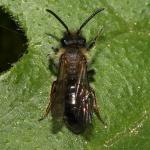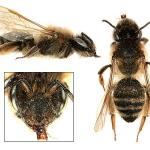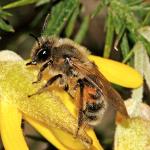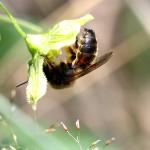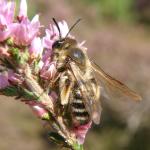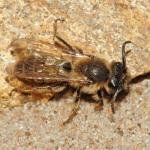Melitta bimaculata Kirby, 1802, Andrena decorata Smith, 1847, Andrena conjuncta Smith, 1847, Andrena articulata Smith, 1847, Andrena vitrea Smith, 1847, Andrena consobrina Eversmann, 1852, Andrena vitreipennis Costa, 1861, Andrena mystacea Dours, 1861, Andrena intermedia Morawitz, 1870 (nec Thomson, 1870), Andrena atro-rubricata Dours, 1872, Andrena aulica Morawitz, 1876, Andrena comparata Morawitz, 1876, Andrena melanura Morawitz, 1877, Andrena paveli Schmiedeknecht, 1883, Andrena magrettiana Schmiedeknecht, 1884, Andrena germabica Radoszkowski, 1893, Andrena vitrea var. tenebrosa Gribrodo, 1894, Andrena atrorubricata var. concolor Alfken, 1914 (nec Robertson, 1898, nec Blüthgen, 1919), Andrena bimaculata var. mondaensis Friese, 1922, Andrena bimaculata var. serotinella Friese, 1922, Andrena morawitzi var. hirtella Friese, 1922, Andrena tibialis var. tricolorata Friese, 1922, Andrena florea var. clavipes Friese, 1924, Andrena blüthgeni E. Stoeckhert, 1930, Andrena bimaculata oligotricha Mavromoustakis, 1952, Andrena gaetula Benoist, 1961, Andrena bimaculata lichata Warncke, 1967
A large, mainly dark mining bee, though the gasters of some females are occasionally extensively marked with red. In general, males are more commonly encountered than females, especially in the spring.
Widespread but very local in southern England north to East Anglia, south central England and south Wales. There are no records from northern Britain or Ireland. It is also reported from the Channel Islands, being known from Jersey.
Iberia, eastwards to the Middle East, Iran and the Far East. Also found in North Africa (Morocco to Tunisia). Gusenleitner & Schwarz (2002) have provided a map of the species’ distribution in the western Palaearctic.
This species is not regarded as being scarce or threatened.
A species associated almost entirely with light, sandy soils, such as heaths, commons and sandpits. It has been encountered at about 330 metres above sea level on Dartmoor, South Devon (Perkins, 1919).
Bivoltine; late March to the end of May, and again from early July to late August.
Nests are excavated in sandy soil and occur either singly (Kocourek, 1966; Westrich, 1989) or in very small aggregations of perhaps only two or three burrows (Perkins, 1919). The nest has been described by Malyshev (1926, 1936).
Poorly documented for Britain, though the spring brood visits daisy and gorse, and the summer brood visits ragwort.
Nomada fulvicornis Fabricius is a cleptoparasite of this bee (Perkins, 1919 [as Nomada lineola], 1924; Yarrow, 1941; Chambers, 1949). Specimens of both broods are occasionally stylopised by Stylops bimaculatae (Perkins) (Perkins, 1919).
2012


